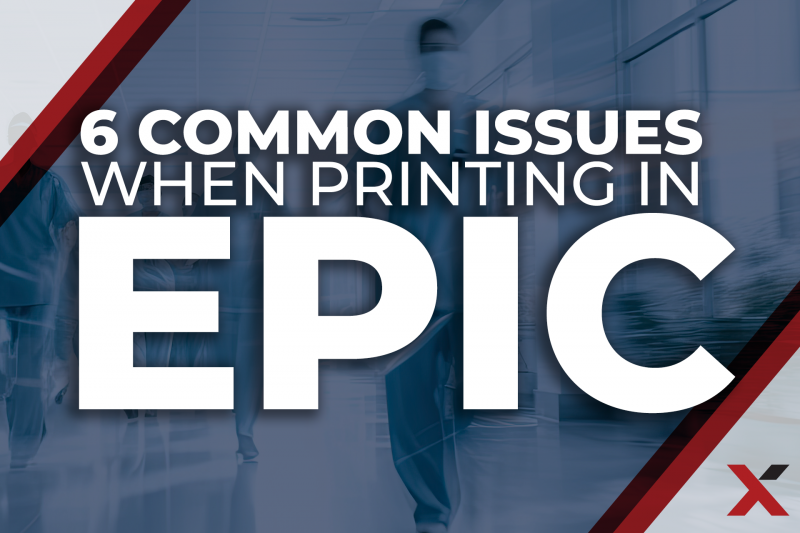Are your team members running into challenges when printing with EPIC? Here are six potential solutions.
EPIC has emerged as the most popular EHR/EMR system in the nation. Electronic Health Record (EHR) systems, also known as Electronic Medical Record (EMR) systems are indispensable in healthcare settings, streamlining patient information management and supporting critical healthcare processes.
Some of the major benefits of EPIC are:
- Improved Patient Care: EPIC facilitates informed decisions with complete health histories and real-time data via the Epic MyChart app, enhancing patient engagement and satisfaction.
- Streamlined Workflow: EPIC automates patient data entry, charting, and scheduling, freeing up staff for critical patient care tasks.
- Enhanced Data Access: EPIC integrates patient care seamlessly with accessible medical histories and treatment plans through cloud-based storage.
- Reduced IT Dependency: EPIC offers a user-friendly interface with extensive support and training, reducing the need for IT assistance.
- Advanced Security: EPIC includes stringent security protocols such as multi-factor authentication, aimed at protecting patient information.
- Regulatory Compliance: EPIC includes tools to maintain compliance with standards such as HIPAA, reducing legal risks.
- Cost Efficiency: Improves efficiency and accuracy, lowers the risk of medical errors, and reduces operational costs through better data management and decision-making.
Despite the robust features available within EPIC and similar platforms, printing within these systems can pose challenges that affect efficiency and user experience. This article explores common printing issues faced by healthcare organizations using EPIC, offering practical solutions to these problems and highlighting the role of Managed Print Services (MPS) providers in optimizing the printing landscape.
1. Difficult EMR/EHR Print Management
Managing printers in an EPIC environment often becomes cumbersome due to the need for individual configurations and manual updates across multiple print servers. This fragmented approach not only consumes time but also increases the likelihood of human error, which can disrupt printing processes.
Solution:
Implementing a centralized print management system can streamline operations. Partnering with an MPS can simplify workflows, allowing IT administrators to manage settings from a single panel. This reduces time spent on configurations and minimizes the chances of errors.
2. Lack of Tracking & Reporting
In many healthcare facilities, the ability to track and report on print jobs is either limited or non-existent. This absence of detailed analytics impedes the organization’s ability to monitor efficiency and implement cost-saving measures.
Solution:
Advanced MPS solutions integrate seamlessly with EPIC, providing comprehensive analytics that help healthcare organizations gain visibility into their print environments. These insights enable the optimization of resources and better management of printing costs.
3. Print Redirection Issues
Print redirection is a significant challenge in virtualized environments like those often used with EPIC. Misconfigurations or compatibility issues between client computers and server-based print systems can lead to failed print jobs and frustrated users.
Solution:
Healthcare organizations can mitigate these issues by using direct IP printing, where print jobs bypass the server and go directly to the printer. This method reduces the complexity of print paths and decreases the likelihood of redirection errors.
4. Poor Driver Management
Driver incompatibility represents a frequent source of frustration in EPIC environments. Outdated or corrupted drivers can cause print jobs to fail, leading to significant delays.
Solution:
Regularly updating drivers and standardizing on universal print drivers across the organization can help maintain compatibility and reliability.
By partnering with an MPS provider such as FlexTG, your healthcare organization can get valuable support in managing these updates, ensuring that all hardware communicates effectively.
5. Data Protection & Compliance Issues
Printing sensitive patient information demands stringent compliance with health data protection laws, such as HIPAA in the United States. Traditional print environments often fall short in securing print jobs, posing a risk to patient privacy.
Solution:
Solutions that include secure pull-printing functionalities not only help in reducing paper wastage but also ensure that documents are only released to authorized users, thereby maintaining compliance and securing patient data. A managed print services provider can provide key guidance to reduce HIPAA vulnerabilities.
6. Label Printing in EPIC
Label printing in EPIC, particularly for patient identification and specimen labeling, is critical and must proceed without errors to ensure patient safety.
Solution:
Zebra label printers are renowned for their reliability and integration capabilities with EPIC systems. Zebra label printers seamlessly integrate with EPIC systems to provide fast, accurate label printing, supporting various media types and sizes with durable, high-resolution output.
These printers are optimized for healthcare, featuring disinfectant-ready designs and privacy-compliant secure printing, enhancing efficiency and patient safety.
Managed Print Services for EPIC
Printing in EPIC environments involves navigating various challenges that can complicate operations and impact healthcare delivery. By partnering with an MPS provider well-versed in the EPIC environment, such as FlexTG, you can significantly alleviate these problems.
FlexTG offers the expertise to implement efficient, secure, and compliant printing solutions that optimize print operations and support the critical work of healthcare professionals.
Reach out to us to learn how you can lower costs, improve workflows, and boost user satisfaction, ultimately contributing to better patient care.

